
Harnessing the Power of No-Code Platforms
As 2024 rolls in, low and no-code platforms are revolutionising our approach to technology. They bring a practical and refreshingly quick solution for those who want to innovate without getting bogged down in complex coding.
They empower all kinds of users to build applications and automate processes, making technology development accessible and streamlined even to those who don’t code!
It's about enabling a broader audience to participate in the digital revolution, because non-coders have bright ideas too. It’s also streamlining things for actual coders, so they can spend more time innovating and less time on grunt work.
Our top 9 no code tools for your app development lifecycle
Monday.com is one of the most versatile tools on earth for planning, managing, and co-ordinating the project. It aids in setting up timelines, assigning tasks, and tracking progress through the entire life cycle of the project.
Its CRM capabilities are vital in managing customer relationships and aligning the development process with user expectations and market needs.
Monday.com is a powerful and flexible no-code platform designed for a wide range of business applications. It's particularly noted for its user-friendly interface, extensive customization options, and powerful automation tools.
What’s more, with ever more innovative Monday apps being developed by independent developers and Monday partners, you can extend the functionality of the platform exponentially.
Key features and functionality
Boards: Monday’s virtual whiteboards help you track and coordinate tasks. They’re collaborative, color coded, and interactive, and you can run multiple projects or aspects at once across multiple boards.
Forms: Monday.com allows the creation of forms to collect data from customers and team members, which can be used for various purposes such as tracking spending, KPIs, deliverables, and collecting feedback.
Automations: The platform offers automation capabilities to streamline processes. You can set up simple "if" and "then" rules to automate tasks like sending confirmation SMS to customers or notifications to support reps.
Integrations: With more than 200 integrations (like Google Sheets, Microsoft apps, Mailchimp, Slack, and Zoom), monday.com enables seamless data incorporation. It also offers an open API for custom integrations.
Dashboard widgets: These include data visualizations like timelines, surveys, charts, maps, and calendars, helping in viewing both overarching goals and detailed metrics.
Docs: Monday docs allow for collaborative document creation, editing, and management straight from your Monday boards.
Customization: Users can build custom features or functionality needed for their business.
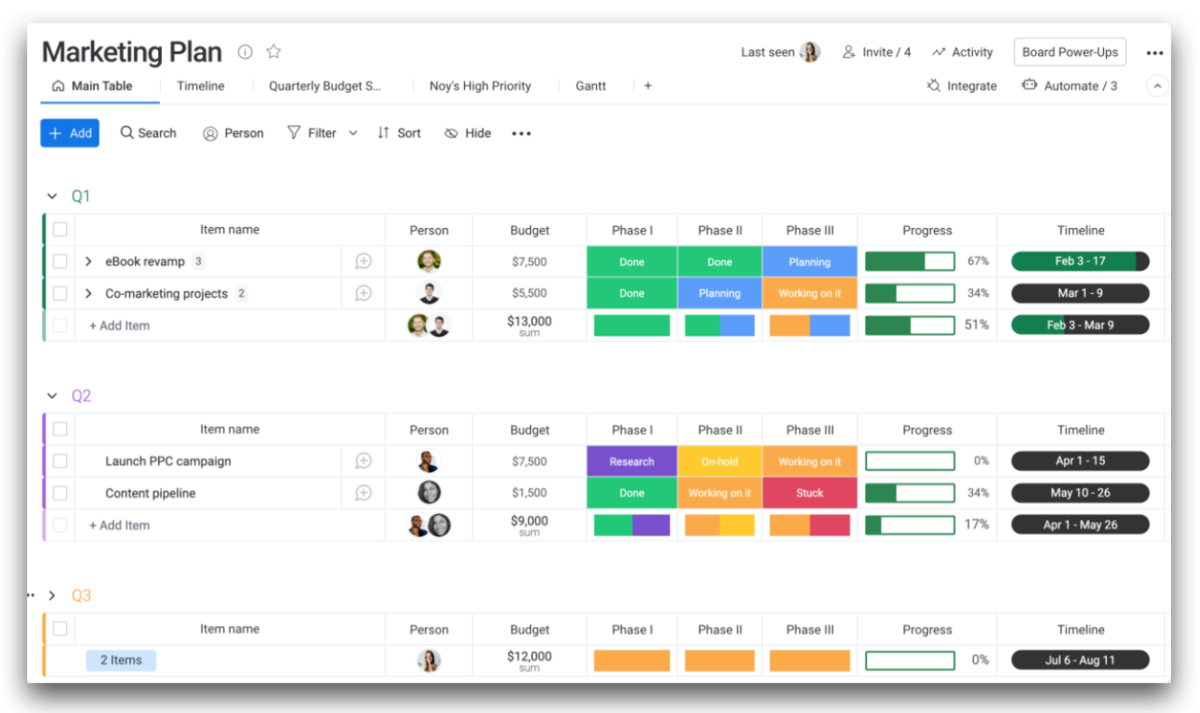
Applications and use cases
Project management: Suitable for managing projects across various sectors, including software development, marketing, and construction.
Marketing and sales: Ideal for managing campaigns, events, leads, contacts, and customer onboarding.
Data management and analytics: Customizable columns and data visualization features enable effective data management and analysis.
Pricing
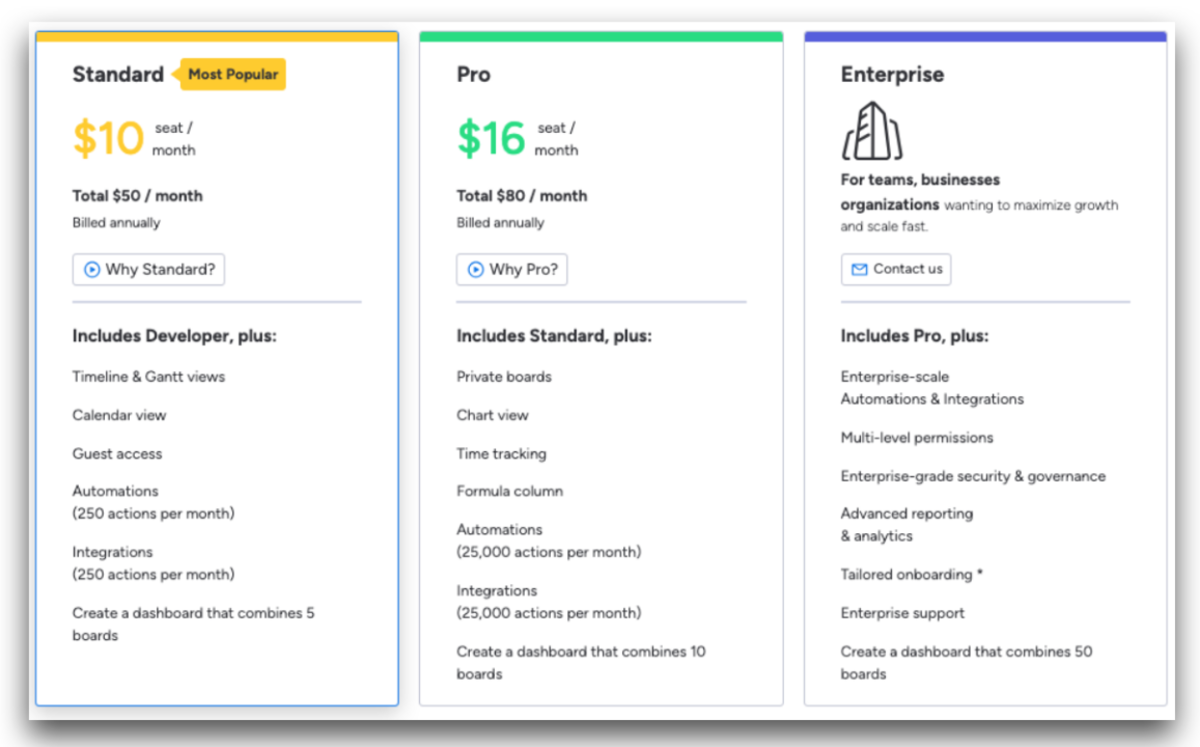
Source: monday.com
Pros
Clean and intuitive interface.
Robust customization options.
Extensive integrations and apps list.
Powerful automation tools.
Suitable even for the most complex projects.
In conclusion, monday.com is well-regarded for its flexibility, extensive feature set, massive scope with apps and integrations, and user-friendly interface, making it suitable for a wide range of business applications.
This cloud-based platform’s user base grows on a daily basis, with close to 200 000 companies signed up across more than 200 industries and 200 countries. They can’t all be wrong.
Jotform is key in the early stages of app development. It specializes in creating custom forms and form-based applications, useful for gathering feedback, conducting market research, and validating ideas.
The platform's versatility allows entrepreneurs and developers to quickly gauge user interest and collect essential data that informs the app's direction. In other words, Jotform can inform your process by helping you ingest and manage data, which you can sync to monday.com with the Jotform for monday.com app.
That’s just the tip of the iceberg though, because Jotform is a no-code platform known for its versatility and user-friendliness, catering to a wide range of business needs beyond just initial research, particularly in creating customized forms and applications for use in your own website or platform.
Key features and functionality
Form builder and advanced form options: Jotform provides a robust form builder with options like electronic signature, pre-populated forms, and autoresponder emails. Users can create various types of forms, including payment and subscription forms.
Custom URL and PWA technology: The platform enables the creation of custom URLs and custom apps complete with branding, widgets, and forms. Apps created with Jotform are compatible with all devices and can be added directly to the home screen of mobile devices and desktop computers.
Embeddable on websites: Users can embed their Jotform applications on websites or share via social media, email, or QR codes, enhancing accessibility and engagement.
Privacy and access settings: Jotform offers advanced privacy and access settings, allowing control over who can use your app and forms.
Integrations and plugins: The platform boasts over 150 integrations with various tools like PayPal, Google Sheets, Slack, and more, facilitating seamless data transfer and processing.
Drag-and-drop app builder: Jotform features an intuitive drag-and-drop app builder with over 600 templates and 70+ widgets, enabling rapid app creation without coding.

User experience and reviews
Users have generally found Jotform to be easy to use and efficient for businesses of all sizes. The drag-and-drop features and wide range of templates facilitate quick and easy form and app creation.
Pricing
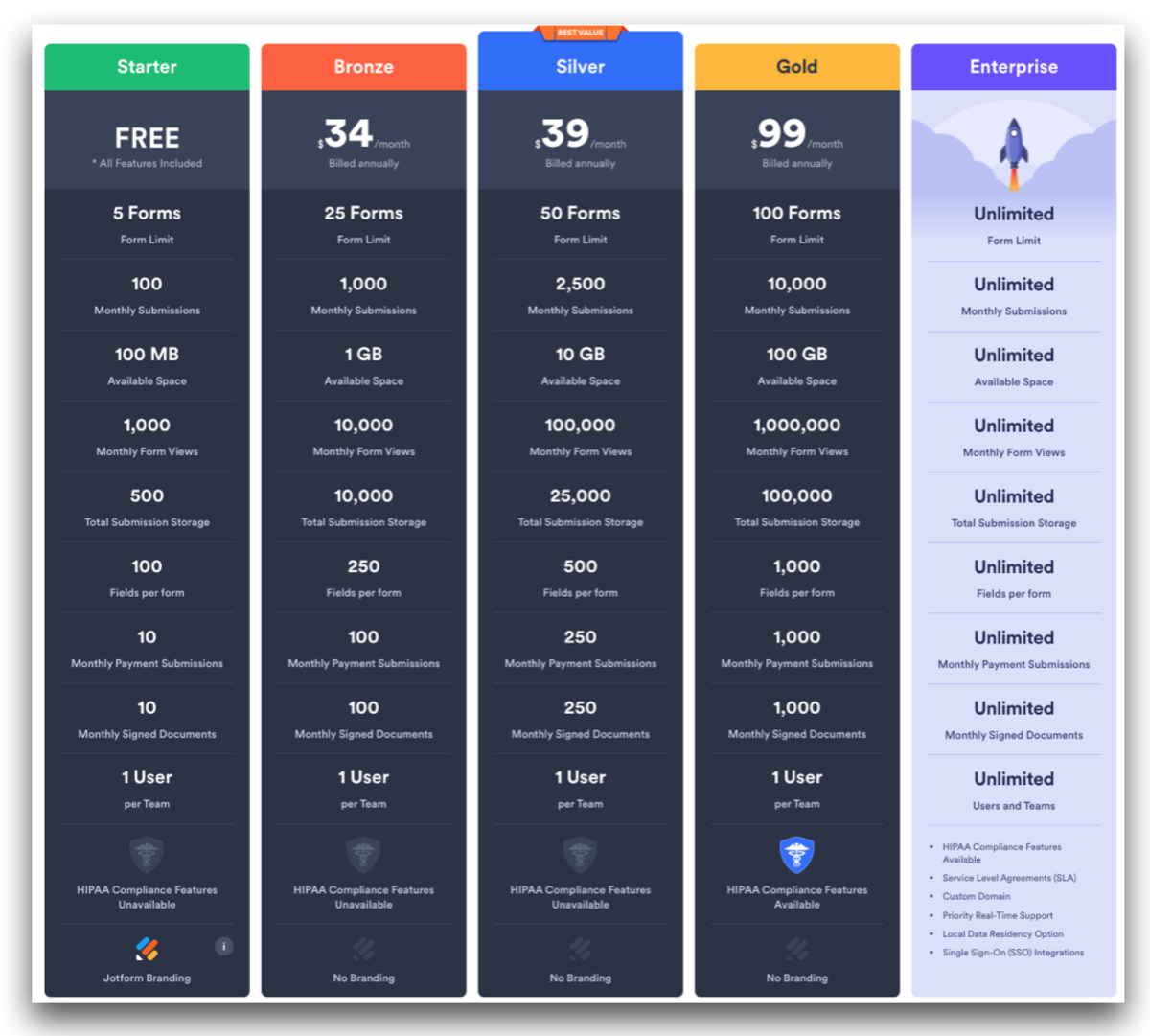
Source: Jotform.com
Pros
Simple and efficient for various business sizes.
Wide range of templates and customization options.
Extensive integrations and plugins.
User-friendly drag-and-drop interface.
In summary, Jotform boasts ease of use, extensive customization options, and wide range of integrations, making it an excellent choice for businesses looking to create forms and apps without coding. Its flexible pricing plans cater to a variety of business sizes and needs.
Make.com is a no-code visual platform for designing, building and automating everything from tasks and workflows to apps and systems.
It provides an intuitive, user-friendly interface that simplifies the creation and management of automated workflows, making it accessible to users without a technical background.
It’s important to note here that make.com lets you integrate just about everything with monday.com.
While Jotform, Sundae, and Coupler.io are all available as monday.com apps, Make will let you integrate apps that aren’t catered to on the monday.com app or integration marketplace—like Bubble.io, the next item on our list!
Make.com connects various stages of development, ensuring smooth transitions between them.
For instance, it can automatically update project status on monday.com or transfer data from Jotform surveys into actionable tasks. Custom automation solutions allow development companies to build and scale their businesses without hitches.
Key features and functionality
Cross-departmental workflow support: Make.com supports workflows across several departments and verticals, such as marketing, sales, operations, IT management, and human resources.
Drag-and-drop builder: The platform features a drag-and-drop interface, enabling easy setup and modification of workflows.
Templates for automation: Make.com offers numerous templates for automating tasks, which helps in streamlining the setup process.
Integration capabilities: It integrates seamlessly with other platforms like ClickUp, allowing for complex workflow automation between different work applications.
Customization options: Users can customize their workspace and applications using ClickApps, a feature within Make.com.

Applications and use cases
Lead processing: streamline customer acquisition
Inventory and supply chain management: enjoy unlimited scaling with sales
Invoicing and billing: automate your business transactional process
Social media management: extend your reach and engage across multiple platforms with minimum effort
Company data management: eliminate silos by merging multiple data sets.
Pricing
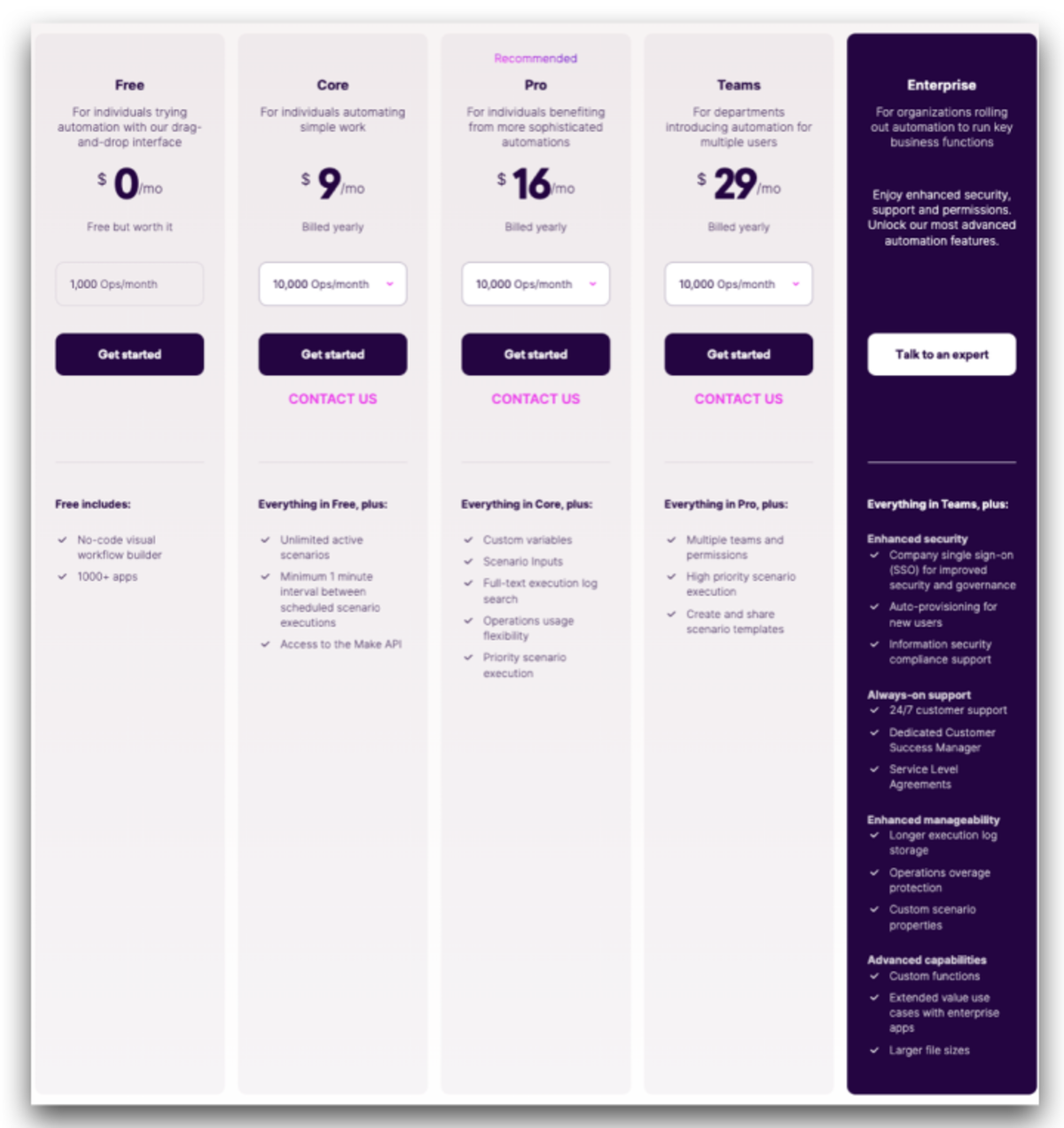
Source: Make.com
Pros
User-friendly interface suitable for non-technical users.
Wide range of templates to save time in setting up workflows.
Supports complex processes and helps in breaking them down into manageable tasks.
Extensive integration capabilities with over 1 500 apps.
In summary, Make.com is a powerful no-code platform for workflow automation, offering extensive integrational capabilities that extend the capabilities of your other tools through integration. It boasts a user-friendly interface, and a wide range of templates suitable for various business departments.
Its pricing model and high user ratings make it an attractive option for businesses looking to automate their workflows without needing extensive technical knowledge.
Its user-friendly interface allows building sophisticated data-based web applications without any coding. It offers flexibility in UI design and functionality, turning any envisioned app into reality.
It is particularly popular for its user-friendly drag-and-drop interface, allowing users, including those without technical backgrounds, to develop and deploy web applications with elegant visual tools.
Key features and functionality
User interface design: Bubble.io offers a range of UI elements that can be customized and arranged to create a clear, logical, and responsive layout that suits the needs of the user.
Logic and functionality: The platform provides a visual programming paradigm for adding workflows and events, enabling the creation of complex functionalities without traditional coding.
Deployment and publishing: Bubble.io allows users to test, debug, and deploy their applications with various tools and techniques for efficient development and troubleshooting.
Integration with external services: It supports integration with a wide range of external services, extending its capabilities beyond its native features.
Responsiveness and design flexibility: The platform ensures that applications are responsive across different devices and offers extensive customization options.
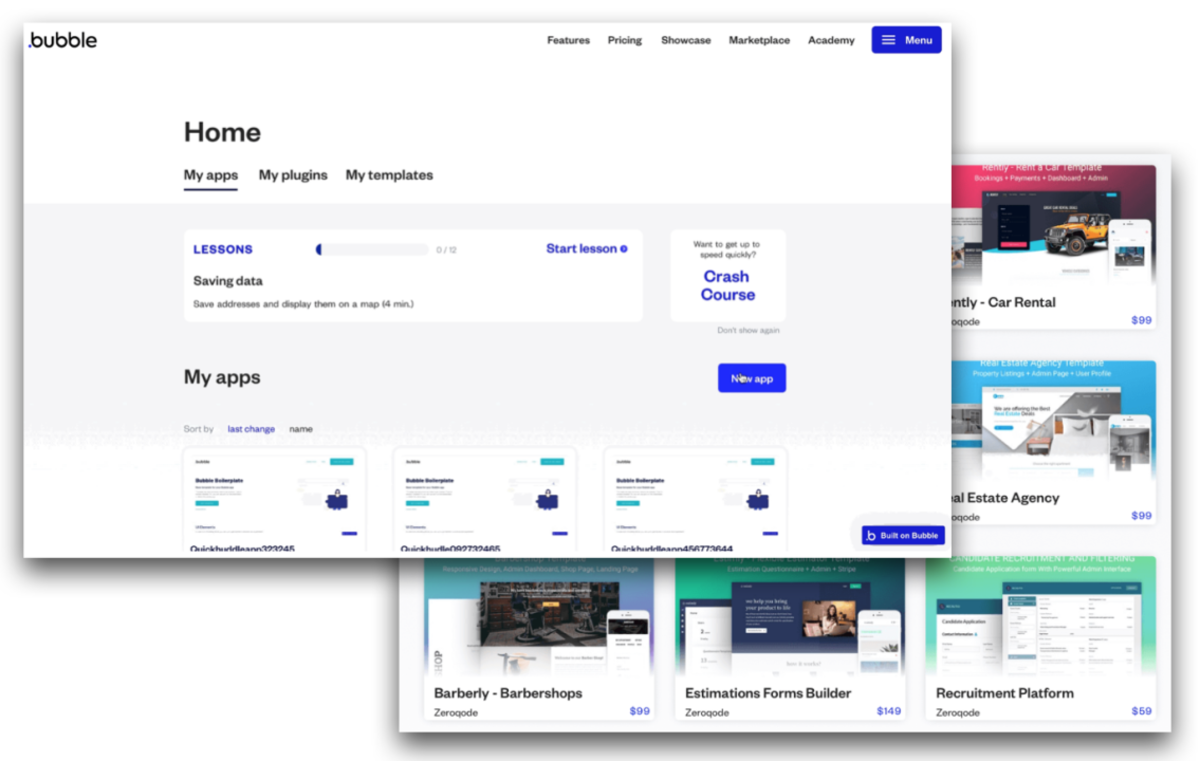
User experience and reviews
Users generally find Bubble.io to be an intuitive and powerful for rapid app development.
The platform is suitable for creating a wide variety of web products, such as marketplaces, CRMs, and community sites. However, while it is user-friendly, there is a learning curve involved, especially for more complex applications.
Pricing
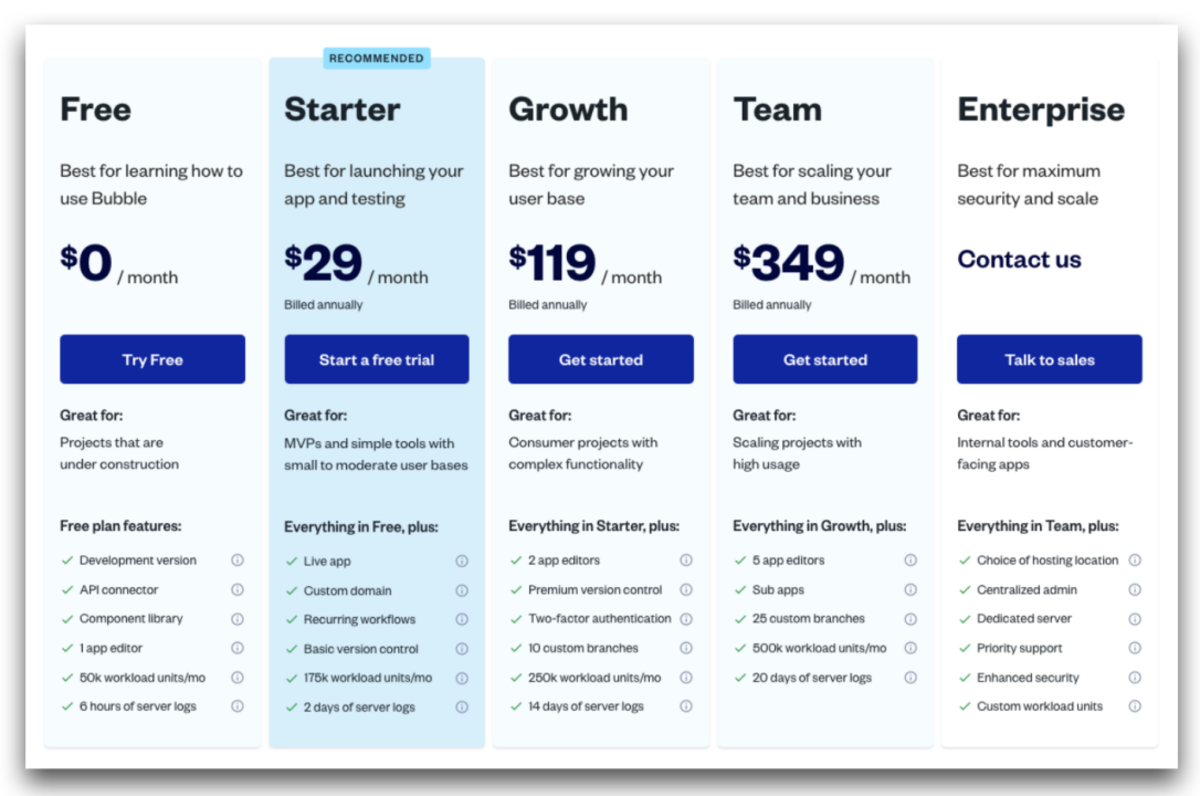
Source: Bubble.io
Pros
No coding required for app development.
Rapid development with a visual interface and drag-and-drop functionality.
Responsive design and extensive feature set.
Collaborative environment for team projects.
Scalability and flexibility for different project sizes.
In summary, Bubble.io is a powerful no-code platform for full stack web app development, offering flexibility, a wide range of features, and scalability.
Its user-friendly approach makes it accessible for a broad spectrum of users, from entrepreneurs and startups building basic apps to enterprise teams building complex online platforms.
Parallel to app development, Sundae.io is essential for creating websites and documentation to market your app and make comprehensive resources available to your users.
As it’s accessed via your monday.com workspace, it turbo charges the process of transforming project documentation saved as Monday docs into stylish, highly responsive public sites.
Sundae.so does allow users to add custom code, but what sets it apart is how easily you can create diverse, interactive websites and pages published from your docs with many of monday’s forms and widgets embedded, without the need to code at all.
Here's an overview of Sundae.so's features and functionalities.
Key features and functionalities
Quick website creation: Build your website in under a minute! Select from various website types like help centers, blogs, wikis, event/sales pages, documentation libraries, and more.
Easy content management: Continue using familiar monday.com Docs for writing and editing, while Sundae seamlessly turns your work into a public-facing website .
Stylish templates: select from a range of sleek design templates for a professional, engaging look, with no code required.
Lightning-fast performance: With the latest technology and CDNs, Sundae ensures your website is not just visually appealing but also exceptionally fast .
Customization without coding: Personalize your website’s look and feel effortlessly with no coding required.
SEO optimization: Make your site stand out with added titles, descriptions, and social cards, optimizing it for search engines .
Scalability and performance: Designed to handle high-traffic situations and large websites, ensuring scalability and high performance .

User experience
Sundae is designed to be user-friendly, with a straightforward process for creating a website. Users can select a website type, choose docs to publish from monday.com, and easily showcase their new site with their own logos, brand palettes and fonts.
The platform is brand new, but since we use Sundae ourselves, we’re expecting plenty of rave reviews.
Applications & use cases
Sundae is particularly useful for users who want to create:
Documentation sites: Transform comprehensive guides or detailed information into a well-organized website.
Help centers: Ideal for FAQ sections or knowledge bases.
One-pagers: Suitable for product launches, events, or standalone documents.
Product sites: like our own site, Sundae.so.
Blogs: Perfect for creating engaging personal, team, or company blogs.
Post-development, Coupler.io enhances the app's value by providing insights through data analytics. All this can be synced to and accessed from your monday.com workspace with the help of Coupler.io’s monday app.
Coupler can integrate with Bubble.io to analyze user interactions and app performance, and both can integrate with monday.com—Coupler through its monday.com app and Bubble via Make.com.
The platform's automation features enable continuous monitoring and reporting, essential for iterative improvements.
A no-code data analytics and automation platform primarily designed to facilitate the gathering, transformation, and analysis of data, Coupler will help you stay ahead of customer trends.
It boasts a user-friendly interface and extensive integration capabilities, making it super-accessible to users without a technical background.
Features and functionality
Data analytics and automation: Coupler.io allows users to connect with over 200 integrations. It's designed to streamline data extraction, stitch data from multiple sources, and simplify cross-channel reporting.
Integration capabilities: The platform offers seamless integration with popular BI tools like Looker Studio, Tableau, or Power BI, allowing for the creation of insightful, auto-updated dashboards using ready-made templates.
Automated data flows: Users can automate data management with features like webhooks and scheduled data refreshing, enabling up-to-date data access at preferred frequencies.
Customization and ETL capabilities: Coupler.io provides options to preview, manipulate, and transform data before transferring it to data destinations. This includes editing columns, calculating custom metrics, and applying sorting and filtering options.
User-friendly interface: The platform is praised for its intuitive dashboard, simplifying data visualization and reporting, even for non-technical users.
Security: High-level security protocols and top-tier data encryption are employed to protect valuable business data in the cloud.
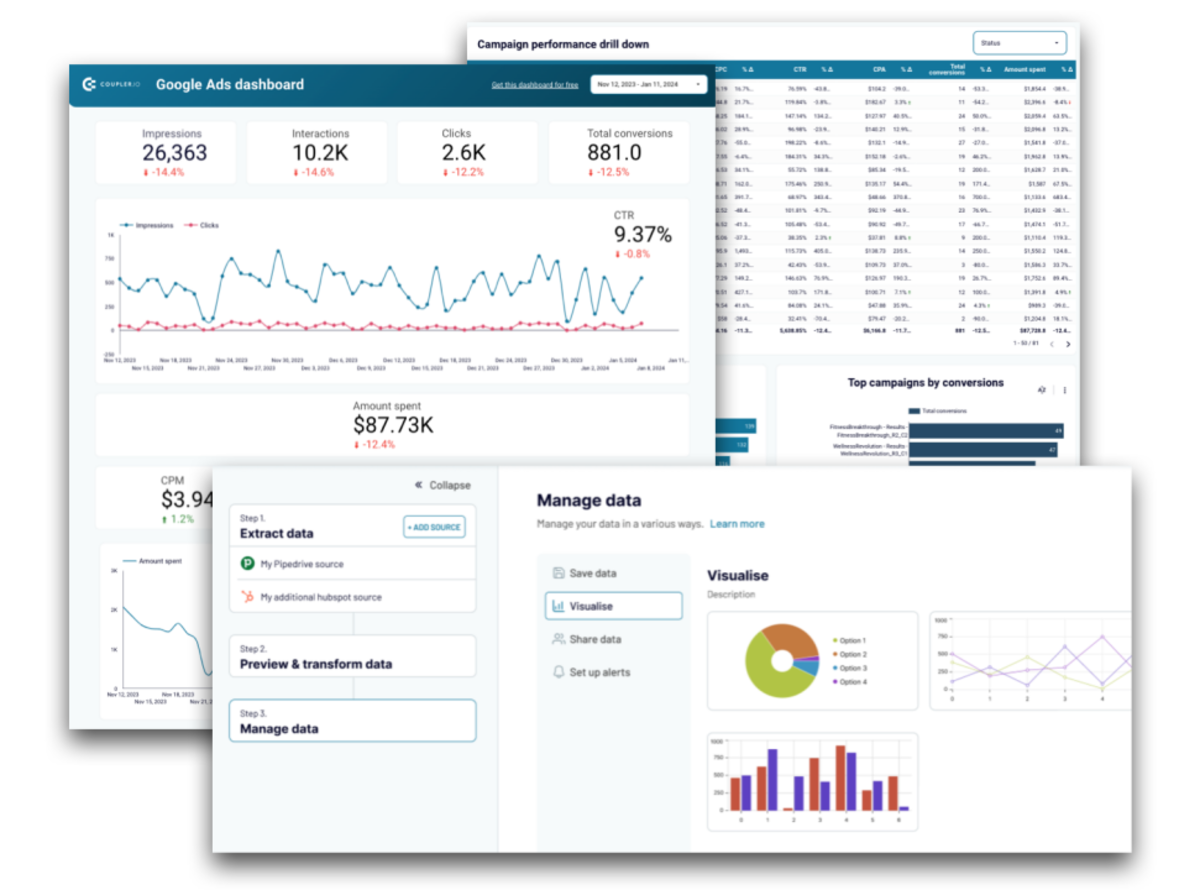
Pros
All-in-one platform for data analytics and automation.
No-code solution with a user-friendly interface.
Custom data analytics services and expert support.
Smooth data importing and exporting capabilities.
Variety of integrations to unify business data.
Pricing
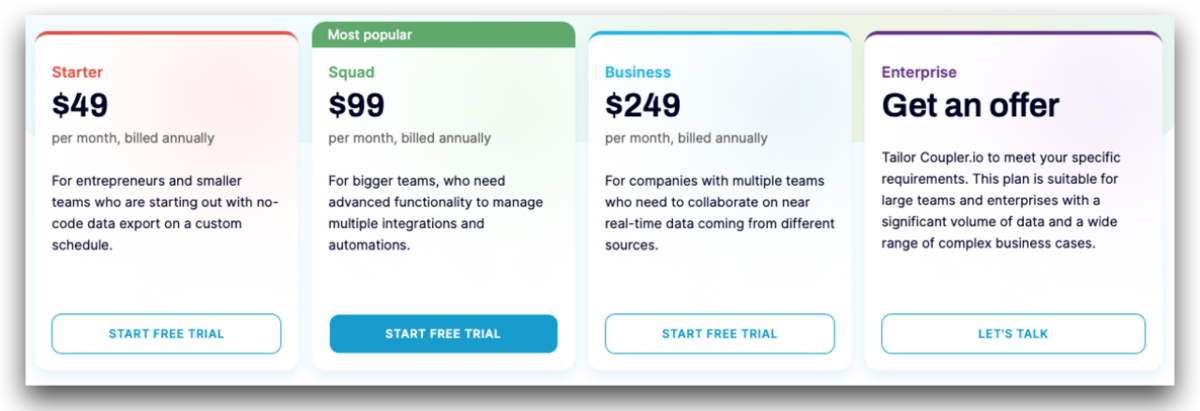
Source: coupler.io
In conclusion, Coupler.io is a robust no-code solution for data analytics and automation, ideal for businesses seeking to consolidate and analyze data from various sources without the need for coding expertise. Its strengths lie in its integration capabilities, ease of use, and strong customer support, though users should be aware of its pricing structure and the potential need for additional learning to utilize all features effectively.
How our top 6 no-code applications work together
Here’s a summary of the role of each no code tool on our list and how they slot together to form a well-oiled app creation and marketing machine.
Monday.com as the operational hub:
monday.com is your base for coordinating the flow of information and tasks across all stages of app development and marketing. This approach ensures that processes are streamlined, data is synchronized, and every phase of the app lifecycle is effectively managed. The integration of these tools maximizes efficiency, enhances decision-making, and ensures a comprehensive approach to app development and marketing.
Jotform for ideation & conceptualization:
In the early stages of app development, Jotform's custom forms are key to gathering user feedback and conducting market research. This data informs the app's direction and can be seamlessly integrated into Monday.com. This integration allows for efficient management of ideas and insights within Monday.com, aligning the development process with user expectations.
Make.com for workflow automation & management:
Make.com enhances the workflow by connecting various stages of development and ensuring smooth transitions. It can automatically update project statuses on Monday.com and transfer data from Jotform into actionable tasks within Monday.com. This integration streamlines the workflow, linking ideation data with project management.
Bubble.io for app development & design:
Bubble.io complements the initial conceptualization and ideation tools, allowing the development of complex apps. Its integration with Monday.com ensures that development progress is tracked and managed effectively within the Monday.com environment.
Sundae.so for website creation & app documentation:
Sundae.so is instrumental in creating websites and documentation essential for marketing your app. It can transform project documentation from Monday.com into interactive websites in seconds. This integration leverages the data and progress tracked on Monday.com for external communication and marketing.
Coupler.io for data analytics & reporting:
Post-development, Coupler.io provides insights through data analytics, essential for iterative improvements. Its integration with Monday.com allows for the monitoring and analysis of data within the familiar interface of Monday.com. Coupler.io can also be linked with Bubble.io for deeper analysis of user interactions with the app.

A vintage no-code cassette
In conclusion
The no-code revolution, with tools like Monday, Sundae, Make, Jotform, Coupler, and Bubble, is clearly redefining business and technology.
This much is evident in the fact that most remote and online workers benefit daily from streamlined no-code platforms like monday.com, and how many startups with little to no coding background are now able to design and launch their own web apps.
These new tools highlight the versatility and impact of no code solutions. Each tool brings unique benefits, simplifying complex tasks and opening doors to wild new levels of creativity and innovation.
Sundae, like the other platforms on our list, exemplifies no-code's transformative potential, turning monday.com documents into interactive websites in a click. This is what monday.com island the other platforms and tools on our list are all about—making technology more accessible and empowering a wider user base.
In conclusion, no-code platforms and tools are not just easing tasks but are opening new horizons of possibilities, ushering in a more inclusive and efficient digital era.
Ready for more innovative monday.com tools, check out our posts on the best monday apps for product management, project management, and marketing teams.
Frequently asked questions
What are no-code tools?
No-code tools are platforms or software that enable the creation of applications and digital solutions without the need for traditional coding. They typically use graphical user interfaces with drag-and-drop elements, allowing users to build and customize applications easily.
What makes no-code tools ideal for non-coders?
No-code tools are designed with simplicity in mind, offering intuitive graphical user interfaces and drag-and-drop functionality. This makes them ideal for non-coders as they can create applications, automate processes, and manage workflows without needing to understand complex programming languages.
How can no-code tools benefit professional coders?
Professional coders can leverage no-code tools to streamline their workflows, automate repetitive tasks, and focus on more complex aspects of development. These tools can significantly reduce development time and allow coders to concentrate on innovation and problem-solving.
What is the scope of projects that can be developed using no-code tools?
No-code tools are versatile and can be used for a wide range of projects. From simple forms and websites to complex business applications, CRM systems, and automated workflows, these tools cater to various needs and industries.
Are no-code platforms secure and reliable for business use?
Yes, no-code platforms are designed with security and reliability in mind. They often come with built-in security features, regular updates, and robust support systems to ensure safe and dependable operation for business applications.
How do no-code tools integrate with existing business systems?
Most no-code tools offer extensive integration capabilities with popular business systems and software. This allows seamless data transfer and process automation across different platforms, enhancing efficiency and reducing manual effort.
What kind of support and resources are available for users of no-code tools?
Users of no-code tools typically have access to a variety of support and resources, including comprehensive documentation, tutorials, community forums, and customer support services. These resources help users maximize the potential of the tools and solve any issues they may encounter.
Can no-code tools be used for mobile app development?
Yes, several no-code platforms specifically cater to mobile app development, allowing users to create and publish apps for iOS and Android without coding. These platforms provide templates, customization options, and publishing tools for a seamless mobile app development process.
What are the limitations of no-code tools?
While no-code tools are powerful and versatile, they may have limitations in terms of highly customized or complex functionalities that require specific coding. However, many platforms are continually evolving, expanding their capabilities to meet more advanced requirements.
How does the future of no-code technology look in terms of innovation and market growth?
The future of no-code technology is promising, with continuous innovation and an expanding market. The integration of advanced technologies like AI and blockchain, along with the growing adoption by businesses of all sizes, suggests significant growth and evolution in this field.